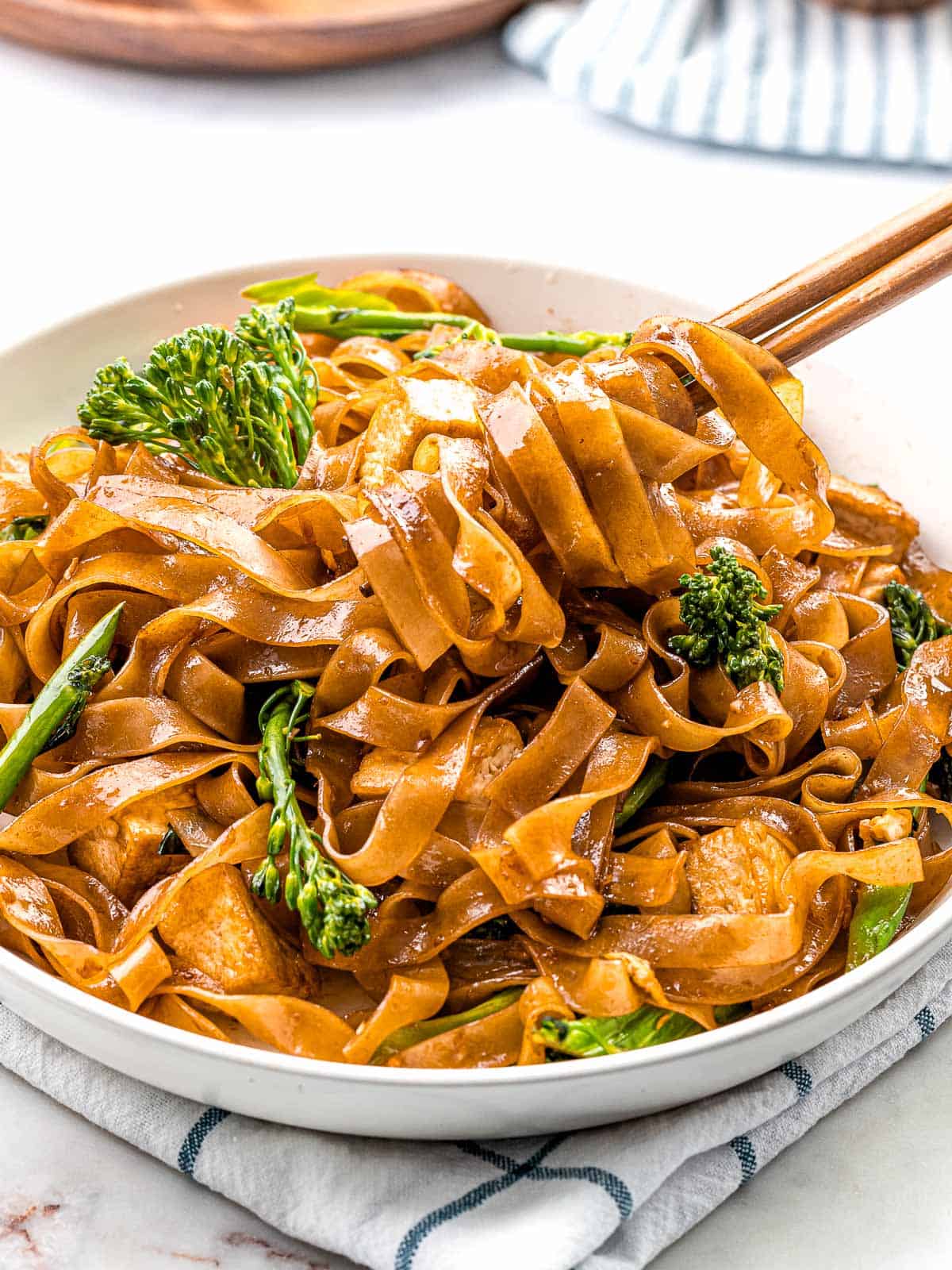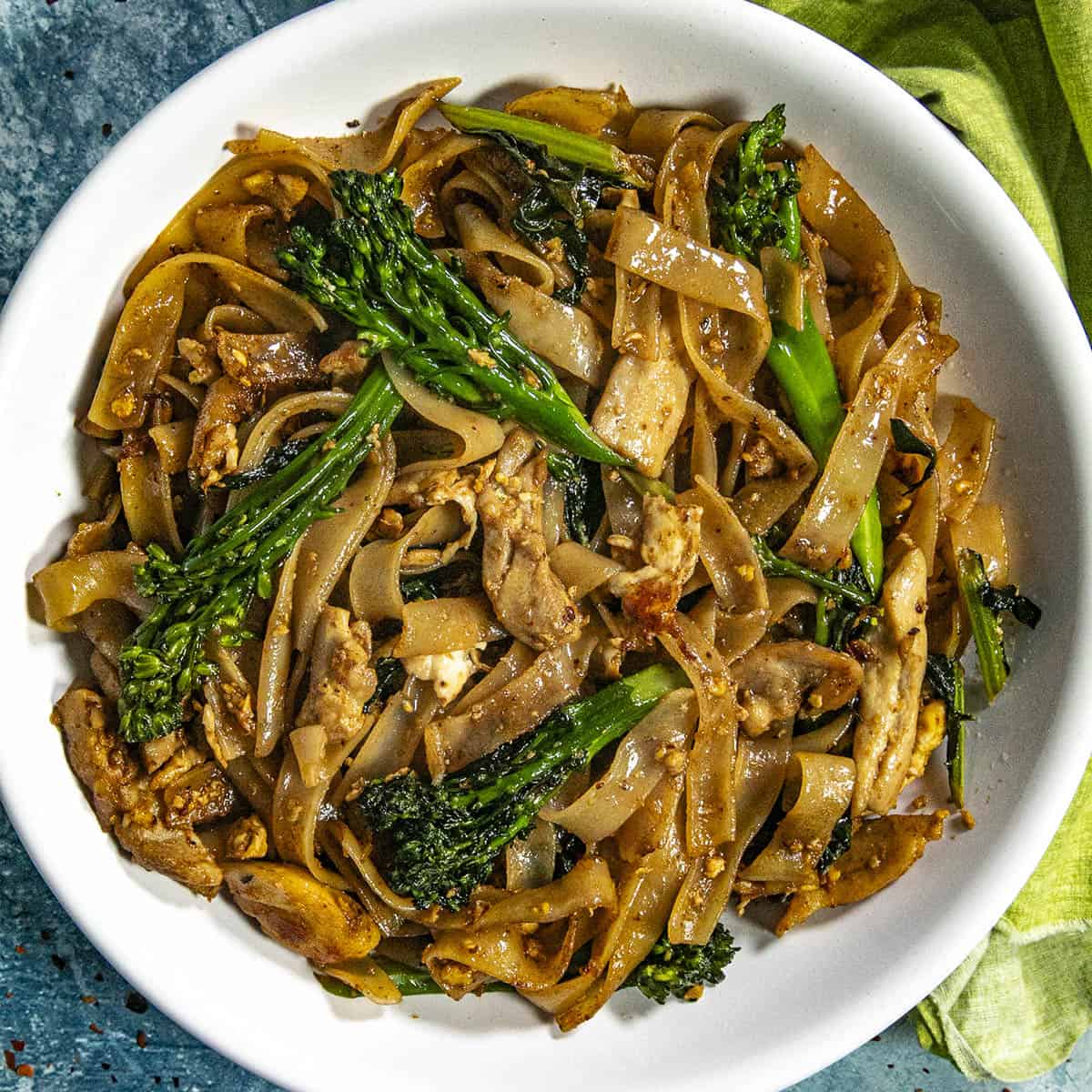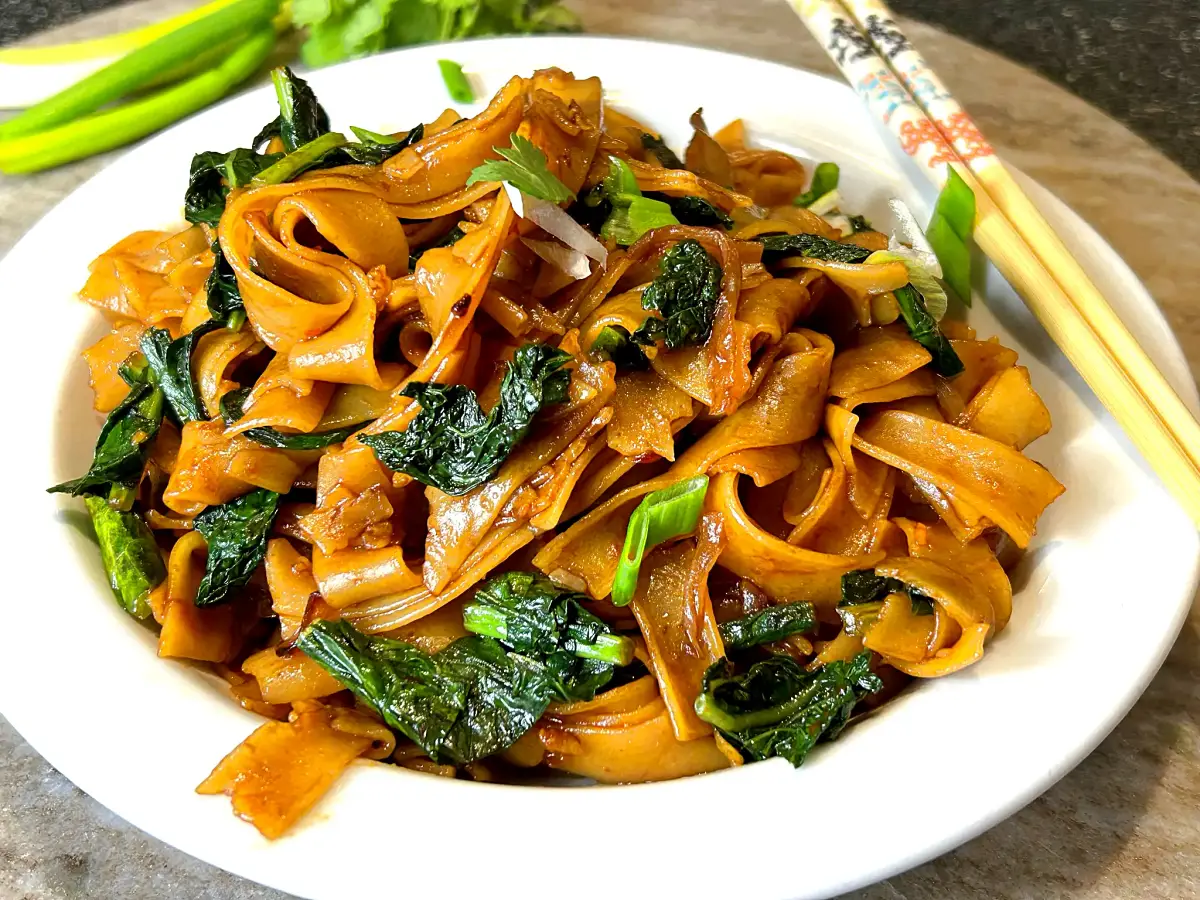Pad See Ew - Your Guide To Thai Noodle Perfection
When you think about the amazing tastes from Thailand, a lot of people might first picture the sweet and tangy notes of Pad Thai, which is, you know, a very well-known dish. But there is, in fact, another noodle dish that holds a special place in the hearts of many who love Thai food, and it offers a really different kind of taste experience. This particular dish brings a savory warmth, a deep, satisfying flavor that just feels incredibly balanced, almost like a comforting hug in a bowl, in a way.
This other noodle creation, often found right alongside its sweeter cousin on menus, tends to be quite popular for its distinct profile. It leans more towards a salty, savory goodness, with that just-right touch that keeps you wanting more, basically. It is, to be honest, a dish that shows off a different side of Thai cooking, one that focuses on rich, umami flavors rather than the bright, sometimes fruity, sweetness that some other dishes are known for.
It's a dish that, you know, really stands out because of its unique mix of simple yet powerful ingredients, cooked quickly and with a lot of heat. It's truly a testament to how simple elements can come together to create something truly memorable, something that, frankly, many people find themselves craving again and again, even after just one taste.
Table of Contents
- What Exactly is Pad See Ew?
- How Does Pad See Ew Compare to Other Thai Noodles?
- Unpacking the Key Parts of Pad See Ew
- Can You Really Make Pad See Ew at Home?
- Achieving That Special Wok Flavor for Pad See Ew
- What About Keeping Your Pad See Ew Noodles Whole?
What Exactly is Pad See Ew?
Pad see ew, written as ผัดซีอิ๊ว in Thai script, is, in fact, a dish that has captured the affections of many people across Thailand and beyond. It is a fried noodle creation that you will find almost everywhere, from street stalls to formal dining places, offering a consistent and comforting taste. This dish is, you know, a staple for a good reason, often picked for its satisfying qualities and its generally pleasing flavor profile that appeals to a wide range of palates. It is, basically, one of Thailand's most sought-after dishes, a true representative of the country's love for quick, flavorful meals.
The way this dish is put together is actually quite straightforward, yet it yields a remarkable depth of flavor. It's cooked with a certain speed over a very hot cooking surface, typically a wok, which is part of what gives it its unique character. The high heat helps to bring out the tastes of the different elements, allowing them to meld together in a harmonious way, so. This quick cooking method also ensures that the components retain some of their individual textures, adding to the overall experience of eating it.
Understanding the name itself can, in some respects, help you appreciate the dish a bit more. The word "pad" is pronounced much like the "pud" you hear in the word "puddle." Then there is "see," which sounds just like the letter "c." And finally, "ew," which, you know, has the same sound as the word "new." Putting it all together, it becomes "pad see ew," a name that, once you hear it a few times, seems to stick quite easily, making it simple to order this delicious item.
The Sound of Pad See Ew
Getting the pronunciation of "pad see ew" just right is, you know, part of the fun of trying new foods from different places. It's not a difficult name to say once you break it down, and it helps you connect a little more with the dish itself. The sounds are, in a way, quite approachable for English speakers, which is good. When you say "pad," think of the soft sound at the beginning of "pudding," a gentle, quick utterance. This initial sound sets the tone for the rest of the word, really.
Following that, the "see" part is, frankly, just like saying the letter "c" out loud. It's a clear, distinct sound that provides a bit of a pause before the final segment. This middle part is, basically, quite simple and doesn't require any special tongue movements or anything complicated. It just flows right into the last sound, which is, you know, rather easy to manage.
And for the "ew" part, you just need to make the sound that rhymes with "new." It's a familiar sound, one that many people use every day, so it should feel quite natural. When you put "pad," "see," and "ew" together, you get the proper pronunciation, which, in fact, makes ordering your favorite Thai noodle dish a breeze. This proper way of saying "pad see ew" also shows a bit of respect for the food and its origins, which is, like, a nice thing to do.
How Does Pad See Ew Compare to Other Thai Noodles?
When you consider the vast array of noodle dishes available in Thai cooking, "pad see ew" truly holds its own, especially when placed next to something like "Pad Thai." There's a common idea that all Thai noodle dishes are, you know, pretty similar, but that's not actually the case. While Pad Thai is often celebrated for its vibrant mix of sweet, sour, and nutty tastes, "pad see ew" offers a completely different flavor experience. It is, in fact, much more focused on savory notes, providing a deeper, more grounded taste that many people find incredibly satisfying.
The distinction between the two is, basically, quite clear once you taste them side by side. Pad Thai, with its tamarind paste, palm sugar, and crushed peanuts, tends to have a sweetness that really comes forward, along with a distinct nutty quality. "Pad see ew," on the other hand, steps away from that profile. It presents a flavor that is, in some respects, more salty and, quite significantly, balanced. This balance comes from a careful mix of sauces that give it a rich, savory depth without being overly sweet or too salty, which is, you know, a pretty good thing.
This particular dish, "pad see ew," really shows off a different side of Thai flavors, one that emphasizes umami and a certain richness. It’s a taste that, frankly, feels more earthy and comforting, often relying on the interplay of various soy sauces to build its character. The absence of the pronounced sweetness and nuttiness found in Pad Thai means that "pad see ew" offers a unique and equally enjoyable journey for your taste buds, one that many people really appreciate for its straightforward, yet complex, savoriness. It is, after all, a dish that stands on its own merits.
Finding Balance in Pad See Ew
The idea of "balance" in "pad see ew" is, you know, really central to its appeal. It's not just salty; it’s salty in a way that feels complete and well-rounded, with a subtle undercurrent that keeps it from being one-note. This balance is, basically, achieved through a careful selection of seasoning ingredients, particularly different types of soy sauce, which contribute various levels of saltiness and depth. There's often a touch of something else, too, perhaps a little sugar or a specific kind of oyster sauce, that helps to round out the sharp edges of the salt, making the overall taste smooth and inviting.
Unlike the bolder, sometimes more assertive flavors of some other Thai dishes, "pad see ew" aims for a harmony that is, in fact, quite gentle but very present. The savory components are, you know, allowed to shine without any single taste overwhelming the others. This means that the earthy notes from the Chinese broccoli, the slight richness from the egg, and the chosen protein all get a chance to contribute to the whole, creating a layered experience. It's a dish where every part plays its role, leading to a satisfying and coherent taste that just feels right, really.
The balanced nature of "pad see ew" is what makes it so comforting and, frankly, so widely loved. It's the kind of dish you can eat often without feeling overwhelmed by strong flavors. The way the saltiness is tempered, and the savory elements are brought together, creates a sense of completeness on the palate. It's a testament to how simple ingredients, when handled with a certain skill, can produce a dish that is, in fact, deeply satisfying and truly memorable, offering a taste that feels both familiar and special, all at the same time.
Unpacking the Key Parts of Pad See Ew
To truly understand "pad see ew," it helps to look at the main things that make it up. This dish is, in some respects, quite simple in its core components, yet each one plays a really important part in creating the overall flavor and feel. The wide rice noodles are, of course, the foundation, providing a chewy and satisfying base. Then there are the fresh greens, typically Chinese broccoli, which add a pleasant bitterness and a nice bit of texture. And you can't forget the egg, which brings a certain richness and helps to bind everything together, basically.
Beyond these main parts, there's always a protein, which can be chosen to suit your liking, making the dish adaptable. Whether it's thin slices of beef, tender pieces of chicken, or perhaps something else, the protein adds substance and another layer of taste. All these elements are, you know, brought together in a hot cooking vessel, seasoned with various soy sauces that are essential to the dish's distinct flavor. It's the combination of these few, well-chosen items that creates the beloved "pad see ew," a dish that is, frankly, more than the sum of its parts.
The beauty of "pad see ew" lies in how these relatively simple ingredients are transformed through the cooking process. The high heat of the wok, for example, quickly cooks everything, allowing the flavors to meld without overcooking the individual components. This quick cooking also helps to create that sought-after smoky taste, which is, in fact, a hallmark of well-made stir-fried dishes. It's a dish that proves you don't need a long list of fancy items to make something truly delicious and deeply satisfying, really.
The Noodles of Pad See Ew
The noodles in "pad see ew" are, you know, a very important part of what makes the dish what it is. These aren't just any noodles; they are wide rice noodles, which have a distinct chewiness and a broad surface that picks up all the wonderful sauces and flavors. Their width means they offer a satisfying mouthfeel with every bite, making them a really comforting element of the dish. They are, in fact, quite different from the thinner, more delicate noodles you might find in other stir-fries, which is, like, a key characteristic.
These specific noodles are, basically, cooked quickly in a hot wok, absorbing the savory seasonings and getting a bit of that special char that adds so much character. The way they are handled during cooking is, in some respects, quite important to keep them from breaking apart, ensuring each strand remains intact and able to carry the full flavor of the dish. They are, essentially, the canvas upon which all the other flavors are painted, providing a substantial and enjoyable base for the entire meal.
The texture of these wide rice noodles is, frankly, one of the main reasons people love "pad see ew." They are soft but still have a good chew, and their broad shape means they can really soak up the rich, savory sauce. This absorption is, you know, what makes every forkful so flavorful, ensuring that the taste of the dish is consistent throughout. They are, in fact, quite robust, yet they need to be treated with a certain care to maintain their integrity during the fast-paced cooking process, which is, after all, a bit of a trick to master.
The Freshness in Pad See Ew
A really important part of "pad see ew" that often gets a lot of attention is the fresh Chinese broccoli. This green vegetable is, you know, not just there for color; it brings a distinct taste and a nice bit of crunch that contrasts wonderfully with the soft noodles and savory sauce. It has a slight bitterness that, in fact, balances the richness of the other ingredients, adding a layer of complexity to the overall flavor profile. This freshness is, basically, quite crucial to the dish, preventing it from feeling too heavy or one-dimensional.
The way the Chinese broccoli is cooked in "pad see ew" is, in some respects, quite quick, ensuring it stays a little crisp while still becoming tender. This quick cooking helps to maintain its vibrant green color and its slightly firm texture, which adds a pleasant bite to each mouthful. It’s a vegetable that, frankly, holds up well to the high heat of the wok, allowing it to absorb the flavors of the sauce without becoming mushy, which is, like, a very good thing.
Including this fresh vegetable means that "pad see ew" isn't just about noodles and meat; it’s about a balanced meal that incorporates different elements for both taste and texture. The presence of the Chinese broccoli adds a refreshing quality that, you know, cuts through the richness of the sauce and protein, making the dish feel complete and satisfying. It’s a simple addition, yet it contributes significantly to the overall enjoyment of the dish, providing that touch of green goodness that many people really appreciate, too.
The Protein in Pad See Ew
When it comes to "pad see ew," the choice of protein is, you know, quite flexible, which is one of its appealing qualities. While chicken is a very common choice, you will often find versions made with beef, or even other kinds of meat, depending on where you are and what you prefer. This adaptability means that the dish can be, in some respects, quite customized to suit different tastes and dietary needs, making it a truly versatile option for many people. The protein adds substance and a different texture to the overall meal, too.
The protein, whether it's thinly sliced chicken or tender pieces of beef, is, basically, cooked quickly in the hot wok right alongside the other ingredients. This fast cooking ensures that the meat remains tender and juicy, absorbing the flavors of the savory sauce without becoming tough or dry. It's a key component that contributes to the satisfying nature of "pad see ew," providing a hearty element that makes the dish a complete and fulfilling meal, which is, like, a very good thing.
The way the protein is prepared for "pad see ew" is, frankly, quite important for its texture and how well it blends with the noodles and vegetables. Often, the meat is sliced thinly, allowing it to cook quickly and evenly, and to pick up all the wonderful tastes from the seasoning. This careful preparation means that every bite offers a balanced mix of soft noodles, crisp greens, and tender meat, creating a harmonious eating experience that many people really enjoy, you know, quite a lot.
Can You Really Make Pad See Ew at Home?
For those who love the taste of "pad see ew" and might think it’s a complicated dish best left to restaurant chefs, there’s, in fact, some really good news. Making "pad see ew" in your own kitchen is, you know, actually quicker and easier than you might imagine. Many people are surprised by how approachable it is, even for those who are not seasoned cooks. The process, while requiring a hot pan and some quick movements, is not overly difficult and can be quite rewarding, basically.
The key to making "pad see ew" at home successfully often lies in having all your ingredients ready to go before you even turn on the heat. This preparation, known as "mise en place," makes the actual cooking part incredibly fast and smooth. Once everything is chopped and measured, the cooking itself is, frankly, a matter of just a few minutes, which is, like, pretty impressive for such a flavorful dish. It’s a good option for a weeknight meal when you want something satisfying but don't have a lot of time to spare.
So, yes, you can absolutely make "pad see ew" at home, and it’s a wonderful way to bring the tastes of Thailand right into your own dining room. With a little bit of

Chicken Pad See Ew

Pad See Ew Recipe (Stir Fried Thai Noodles) - Chili Pepper Madness

Pad See Ew Noodles - Aroma and Essence